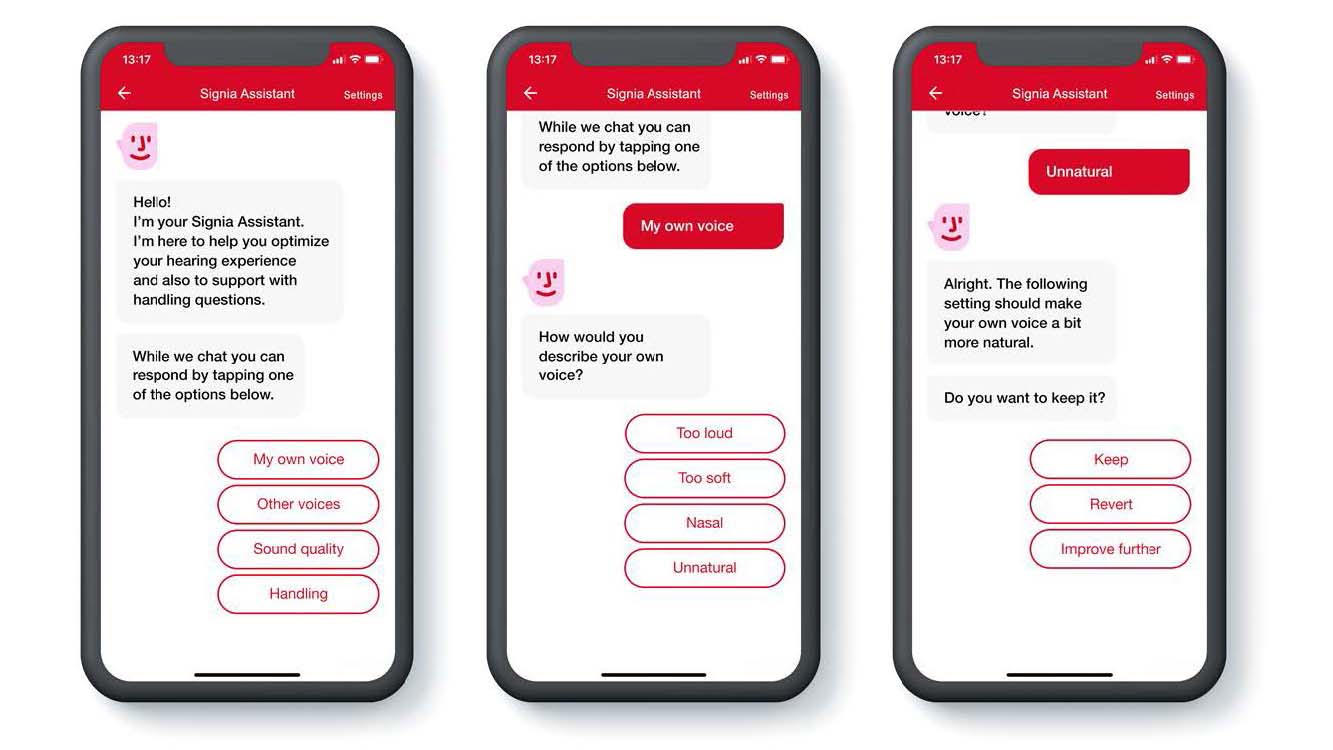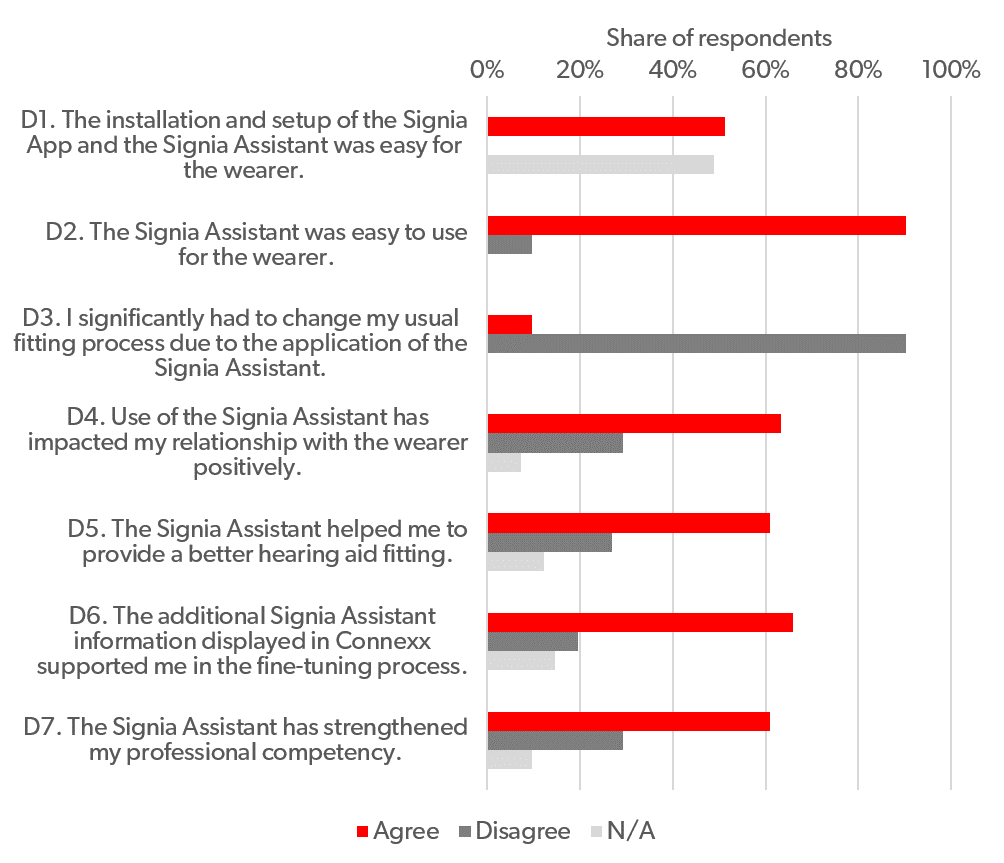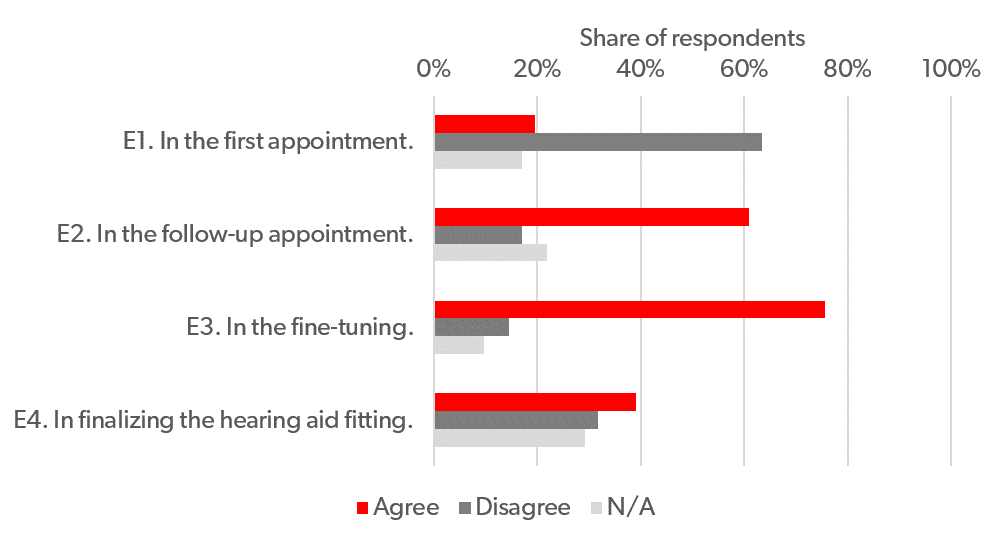
AI Assistant Improves Both Wearer Outcomes and Clinical Efficiency
To investigate the benefits of an AI assistant to support the individualization of hearing aid fittings, 58 hearing aid wearers were surveyed. The results showed Signia Assistant is perceived as easy to use and improves the fitting for individual wearers in difficult listening situations. Further, it increases the clinician’s ability to optimize the fitting more accurately to the individual and strengthens the provider-wearer relationship.
Created Updated
Written by Erik Harry Høydal, MSc; Niels Søgaard Jensen, MSc; Rosa-Linde Fischer, PhD; Sascha Haag, MBA; and Brian Taylor, AuDPublished on The Hearing Review, Nov 1 2021
Over the past two decades, hearing aids have evolved in some remarkable ways, including the ability to identify and process sounds in the listening environment wearers want to hear. During this time, hearing aids have advanced from the use of a screwdriver to make one or two basic adjustments to having countless fine-tuning options available in computer-driven fitting software.1
Despite the advancements in how hearing aids are adjusted, methods used to fit hearing aids have not changed. For example, we continue to rely on wearer feedback, which is highly variable and subjective, as a basis for nearly all fine-tuning decisions.2 While good provider-wearer dialogue is always crucial, we often ignore the fact that many wearers cannot always find the language to describe sound or accurately recall situations where they had problems hearing. During follow-up appointments this means the hearing care professional (HCP) must make educated guesses about what might fix the problem—in the perfectly quiet clinic—before sending the wearer home for another trial round in real-world listening situations. In some cases, the result may be a long trial-and-error process in which the wearer needs to go back to the clinic multiple times before an acceptable adjustment to the hearing aids is found—and sometimes an acceptable adjustment may never be found.3
While these shortcomings are well-known, until recently, there have been few alternatives. Fortunately, new technologies bring new possibilities that remove much of the uncertainty related to hearing aid fine-tuning and adjustments. In this article, we explore how new Artificial Intelligence (AI) technology can improve the outcome of individual hearing aid fittings and how it affects the workflow of the clinic.
Introducing an AI Assistant
In 2020, Signia introduced Signia Assistant, a new AI-driven fitting approach. Signia Assistant enables hearing aid wearers to get instantaneous improvements in specific listening situations encountered during everyday life. Activated by just a few clicks of an app on the wearer’s smartphone, Signia Assistant accomplishes this feat in seconds via the use of a live Deep Neural Network (DNN). A live DNN continuously learns from the interaction with the wearer, allowing for progressively more individualized adjustments in the hearing aids.
An example of how it works is illustrated in Figure 1. When the wearer needs help, they activate Signia Assistant via the Signia App and select the type of problem that needs to be solved. A solution to the problem is then presented as a change in the parameter setting in the Universal program, and the wearer can then decide to keep or discard the change. This procedure enables the live DNN to learn about the wearer’s individual listening preferences and allows for a more individualized, data-driven choice when determining the best possible hearing aid adjustment for common wearer problems. Importantly, the live DNN benefits from anonymous data gathered from other users of Signia Assistant around the world to make these tailored adjustments for the individual wearer. For more detailed information, see papers by Høydal et al<sup>4,5</sup> and Wolf.<sup>6<sup>

Figure 1. The user interface of Signia Assistant. The wearer specifies a problem, and a solution is presented, which the wearer can keep, revert, or further improve.
Signia Assistant also offers new possibilities for the HCP in the fitting and fine-tuning process. The information gathered during the wearer’s use is fed back to the HCP who, using the Connexx fitting software, can see the problems reported and the solutions provided by Signia Assistant. This provides valuable information that supports the HCP in the interaction with the wearer during a follow-up appointment. Using the data provided, the HCP obtains much of the information missed during the traditional fitting approach, where educated guesses are common. Thus, by including Signia Assistant in the adjustment process, HCPs make better data-driven decisions, while counseling and providing additional fine-tuning to the wearer’s hearing aids.
Here, we report the findings from a survey which investigated the use and impact of Signia Assistant—from both the wearer’s and the HCP’s perspective.
Methods
This survey was conducted in Germany. The survey respondents were: 1) Typical clients seen in private practice hearing aid clinics, fitted with new Signia hearing aids and who had access to Signia Assistant on their smartphones, and 2) The HCPs who conducted the fittings.
The wearers answered questions three times during the fitting process: A) At the first fitting, just after being introduced to Signia Assistant, but before using it; B) At the first follow-up visit, and C) At the final fitting appointment. The HCPs answered the questions after completion of the fitting of each respondent.
Survey data was collected from 58 wearers (34 males and 24 females, average age: 66 years) who completed all three questionnaires. In 41 of the 58 cases, the associated HCP questionnaire was completed. The HCP survey data correspond with questionnaires completed by those 41 cases. Data shown here comes from a subset of items on the questionnaire which focused on ease of use, overall wearer benefit, and how the Signia Assistant affected the wearer-HCP relationship.
In most cases, the respondent was asked their level of agreement to a given statement using a 6-point Likert-type scale from “strongly disagree” to “strongly agree” (or N/A option). When reporting the data, the three lower scale points are pooled in a “disagreement” category, while the three upper scale points are pooled in an “agreement” category.
Results
The wearer’s perspective. Results from the wearer questionnaires are shown in Figure 2. In Question A1, 79% of respondents indicated the opportunity to use Signia Assistant had a positive impact on their interest in trying out new hearing aids. In the next item (A2), 59% stated it was easy to install on their smartphone. For this item, the N/A response option was labeled “done by HCP” to include the cases where the HCP did the installation, and this accounts for 36% of the responses. Thus, for those who were able to install Signia Assistant on their own, the vast majority found it easy to do. In the third item (A3), which was asked after being introduced to—but before using—Signia Assistant, 95% of wearers indicated that they understood the handling and function of it. In summary, these items show wearers were very positive toward Signia Assistant after being introduced to it, and they found it easy to get started, once they were given some instruction and guidance from the HCP.

Figure 2. Share of responding wearers who agreed or disagreed to the listed statements. Items labeled A were administered at the first fitting (after installation of and introduction to Signia Assistant), items labeled B were administered at the first follow-up visit, and items labeled C were administered at the final appointment. In item A2, the N/A option was labeled “done by HCP.”
The next group of items in Figure 2 (B items) were administered at the first follow-up visit where the wearers had used Signia Assistant during daily life. An impressive 91% of respondents found the interaction easy and intuitive (B1), 62% had experienced immediate improvements in difficult listening situations (B2), and 69% expressed that the ability to get help made them more confident using their hearing aids (B3). Thus, not only was Signia Assistant able to provide instant help in problematic listening situations, it positively affected the entire wearer experience.
The third group of items in Figure 2 (C items) were administered at the final fitting appointment, on average 3 weeks after the first fitting. Here the wearers were asked about the combined effect of the HCP and Signia Assistant in the fitting process. A total of 79% stated that Signia Assistant had helped them feel connected with the HCP during the fitting process (C1); 78% felt that, together with the HCP and Signia Assistant, they had been able to optimize the setting of their hearing aids (C2); and 69% stated that Signia Assistant quickly helped them get the most out of their new hearing aids (C3). Combined, these results indicate Signia Assistant has strong potential to strengthen the relationship between wearer and HCP—a cornerstone of long-term client benefit.
The HCP’s perspective. The first two items in Figure 3 (D1 and D2) suggest the HCP perception is similar to that of the wearer for ease of installation, setup, and use of Signia Assistant. As was the case for the wearers, the N/A option was labelled “done by HCP” in item D1, accounting for the high share of N/A responses. It is worth noting that none of the HCPs indicated the installation was problematic for the wearer, and 90% found Signia Assistant was easy for the wearer to use.

Figure 3. Share of the responding HCPs who agreed or disagreed to the listed statements. In item D1, the N/A option was labeled “done by HCP.” The questions were answered after the final fitting appointment.
The remaining results in Figure 3 shed light on how Signia Assistant affects the HCP and how it supports the clinical workflow. The responses to item D3 indicate that adding it to the clinic’s workflow doesn’t affect the normal fitting routine, as 90% disagreed with the statement that their usual fitting process had to be significantly changed. Additionally, 63% found Signia Assistant had a positive impact on their relationship with the wearer (D4), and 61% stated it had helped them provide a better hearing aid fitting (D5).
An important feature of Signia Assistant is that the interaction with the wearer—and the changes made to the hearing aid settings during use—are made available to the HCP via Connexx fitting software. This feature allows the HCP to discuss the specific listening experiences that require fine-tuning adjustments when the wearer returns to the clinic. In the survey, 66% of the HCP respondents expressed the information provided by Signia Assistant supported their ability to fine-tune the hearing aids (D6). This is likely one of the reasons why 61% of the HCP respondents agreed that their professional competency had been strengthened as a result of using Signia Assistant (D7).
Another part of the HCP questionnaire investigated when in the fitting process Signia Assistant had been most helpful. The questionnaire specifically asked about four different elements of the fitting process (Figure 4). Not surprisingly, the value perceived by the HCPs varied over the different elements. The most value was experienced during the fine-tuning (done at any appointment) where 76% of the HCP respondents found Signia Assistant helpful. This finding is consistent with the results reported in item D6 above. Placing second, with 61% of respondents finding it useful, was the first follow-up appointment (eg, when doing counseling or interacting with the wearer besides fine-tuning). As expected, the least value was experienced during the first appointment where wearers were first introduced to the tool but did not yet use it. Nevertheless, there were still 20% who found Signia Assistant helpful at the initial fitting appointment. This could, for example, be due to use of the instructional videos on handling of the hearing aids, which are included in the app. These videos support the HCP when giving the necessary instructions to the wearer and serve as a support tool for the wearer between appointments.

Figure 4. Share of the responding HCPs who agreed or disagreed to the statement “The Signia Assistant was most helpful…” for each of the four options indicated. The questions were answered after the final fitting appointment.
The positive impact of Signia Assistant on various segments of the fitting process, reported by both the HCPs and wearers, suggests that the fitting process can be made more effective and perhaps shortened by reducing the duration and number of follow-up visits to the clinic. While some of the HCPs in the survey followed their normal protocol using a fixed time schedule, others reported that using Signia Assistant had allowed them to shorten the duration of the fitting process.
Discussion
These results show the potential benefits for both wearer and HCP when including Signia Assistant in the hearing aid fitting process.
Consistent with a previous study,4 the results suggest wearers were more confident in their ability to use hearing aids, likely because they have a 24/7 support tool available. Additionally, this survey of 58 wearers indicated high favorability for ease of use of Signia Assistant, as well as the respondents’ ability to better collaborate with their HCP. Also, the tailored instructional videos embedded in Signia Assistant might reduce the uncertainty associated with initial hearing aids use, experienced by many first-time wearers.
Results of the HCP portion of this survey provide us with three valuable considerations:
- HCPs indicated Signia Assistant made the fine-tuning process easier, which helped them create a more individualized fitting and address unique wearer needs in a more precise manner. This suggests HCPs are receptive to using more data-driven insights for hearing aid optimization when given the tools to do so.
- Results indicate the need and benefit of a new fitting approach in which wearers can fine-tune their hearing aids while immersed in their own listening environment, rather than the quiet, contrived conditions of the clinic. With new AI-based tools, HCPs gain improved access into how individual wearers fine-tune their hearing aids in real-world listening situations.
- If overall wearer satisfaction is equated to the closeness of their relationship with the HCP (C1) and their ability to get the most from their hearing aids (C3), these survey results suggest a more individualized, AI-based approach, like the one provided by Signia Assistant, is an essential component of a modern approach to fitting and fine-tuning hearing aids. Combined with quicker and more targeted hearing aid fittings and adjustments, results of this survey demonstrate that AI assistants can also positively influence clinical workflow by reducing appointment time without compromising quality of care.
References
- Taylor B, Mueller HG. Fitting and Dispensing Hearing Aids. 3rd ed. Plural Publishing; 2020.
- Anderson MC, Arehart KH, Souza PE. Survey of current practice in the fitting and fine-tuning of common signal-processing features in hearing aids for adults. J Am Acad Audiol. 2018;29(2):118-124.
- Bennett B. Underreported hearing aid problems: No news is good news, right? Wrong! Hear J. 2021;74(2):16-19.
- Høydal EH, Fischer R-L, Wolf V, Branda E, Aubreville M. Empowering the wearer: AI-based Signia Assistant allows individualized hearing care. Hearing Review. 2020;27(7):22-26.
- Høydal EH, Aubreville M. Signia Assistant backgrounder [white paper].
- Wolf V. How to use Signia Assistant [white paper]